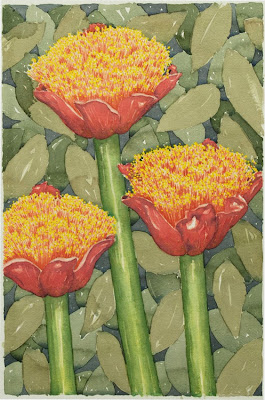Well, 2013 was an action-packed year here at Garden Amateur land. Early on in the year I lost my job and became an involuntary semi-retiree. That's the bad news (and it actually turned out to be not so bad after all).
The good news is that Pammy's career as an exhibiting artist is really getting up to speed, and our lovely little garden has continued on its way with its usual combination of flourishes of growth, productive crops of produce, seasonal colour… plus mini-disasters (thanks mostly to Huey the weather God and the Insect Pest Garden Munchers Union). So here's a few photos to show what happened, plus we pick our prize-winners of the year, and look forward to 2014.
 |
| Gardeners love talking about the weather, and on January 8, we had some news to report: The Hottest Day Ever in Sydney. It was ridiculous, 45°C, or 113°F. And that just set the tone for what has turned out to be Sydney's hottest year ever. It was our hottest, driest winter ever this year, then we went through a super hot October as well. |
 |
| The final ever issue of Burke's Backyard magazine, the March issue, hit the newsstands with a wonderfully memorable cover (that went on to actually win the Maggie Award for best home & garden magazine cover of the year). And so with the closure of Burke's Backyard after 14 happy years there, I was looking for work. |
 |
| Fortunately for me, the first few months of part-time work consisted of helping Don Burke to research and write his new book on herbs and spices. |
But all of that finished by May, and since then (and for the rest of this year) the best I have managed to do is find whatever casual work I can scrounge as a writer and sub-editor. Some old friends in the publishing industry have been very kind and supportive and so I have found a fairly steady supply of part-time work, enough to pay all the bills, and I am loving it. I never thought I'd be a retiree, but I did turn 60 this year, and I'm now looking forward to a life where I work just 20 or so hours a week, and spend a lot more time gardening, reading and pottering about.
And speaking of pottering about the garden, here's a few snaps of some highlights for me in this, our 22nd year here in our little Marrickville backyard.
Most welcome garden visitor of 2013
 |
| This year's winner is the native blue-banded bee, who made his or her presence felt with some very loud buzzing, plus a curiosity that borders on nosy-ness whenever I enter its space. Read about it here. |
Vegie of the year
 |
| A scene stealer, and delicious, too, this is Collard Greens, a classic vegie of Southern USA Soul Food, grown from seed that came with my Soulicious eCookbook. Read about it here. |
Flower of the Year
 |
| A sentimental favourite, our Love-in-a-Mist blooms, which were started from seed, put on a pretty show. I haven't grown them for a few years, but this year I have saved lots of seed, so I expect that I'll be blogging on either my success or failure as a seed saver and grower sometime around spring in 2014. |
Parent of the year, 2013
 |
| What a memorable show our Scadoxus puts on every year, and this year was no exception. The wonderful news is that our scadoxus is loving life here so much that it is sending up baby plants around the base of each bulb, and all bulbs are now blooming. I have optimistically gathered its seed and have sown them direct into the ground nearby as well, but I have been told germination is iffy and slow, so we'll see how that little experiment goes sometime into 2014. |
Artist of the Year 2013
 |
| OK, I plead guilty to nepotism, but Pammy's work as an artist really is blossoming into something very exciting. She participated in several group shows this year in a number of galleries (but most notably at Gallery Red in Glebe) and her solo exhibition at the Eden Gardens Garden Centre has already recorded lots of sales, and Eden Gardens has extended its run until February 5, so if you thought you might not find time to see it before its old scheduled closing date in early January, you now have one whole month extra to get along there. You can read more about her show here. |
And to finish off, here's wishing all my fellow gardening bloggers and my lovely blog readers and commenters a very happy New Year and a wonderful 2014.
As well as marking up my 60th year here on planet Earth, my blog notched up its fifth birthday last June, my little spinning globe visitor-counter on my home page, which has only been running for a couple of years, spun past its 200,000th visitor just before Christmas, and my Google Stats, which counts the number of visitors here since the very beginning, tells me that my quiet little backwater of a Garden Amateur blog will log up its 500,000th visitor sometime in March 2014. That's a lot of people to thank, so I'll just quote one of Marrickville's most famous sons, and say "I love youz all".
See you in 2014!












































